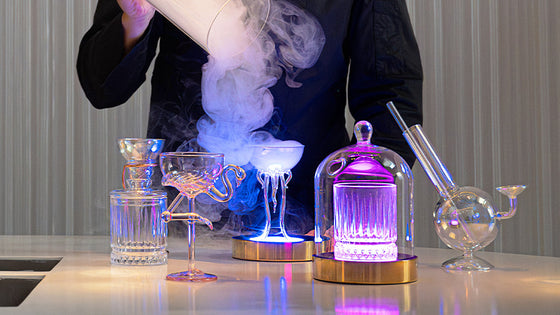Match the Glass to Your Cocktail for A Quality Cocktail Drinking Experience
When choosing the perfect glass for your cocktail, there are four variables to consider. They are the texture and temperature of the liquid, the volume the glass should hold and finally, the appeal to the senses that directly affect the guests desire to drink it. The first three factors have been explored beyond the cocktail industry by people serious about drinking wine and spirits.
However, it is cocktail barmen who push the envelope when it comes to glassware that appeals to the guest. For example, tiki culture has expanded the notion of what can technically be called a glass. In tiki bars, you may see drinks served in shells, figureheads, totems, treasure chests or hollowed-out fruits. But even in elegant, five-star hotel-style drinking establishments, current bartenders use garnishes and glassware to stand out from their illustrious neighbours.
And for a good reason, science has established that mood, sight, sound, touch, smell and emotions work together, subconsciously, to affect our desire to imbibe. Then, the proliferation of social media means that venues need to convey their entire guest experience with one super attractive visual image that screams drink me with all the subtlety of the bottle of potion in Alice and Wonderland. But unlike social media, this is not a new phenomenon. Hollywood and television have a lot to answer regarding glassware whims and fancies.
Texture Determines the Shape of the Glass
While the effect of texture on the senses relates to biology and psychology, the shape of your glass is designed to suit the physics of viscosity. For example, the sides of a wine glass bow inwards towards the rim, whereas a traditional martini glass has sides that flower outwards. The idea is that the shape of the glass concentrates (or not) the invisible flow of alcoholic vapours that affect our sense of smell when the glass is lifted to our face. The intensity of the aromas correlates with the ratio between the diameter of the widest part of the glass to the diameter of the opening.
We also move our heads differently for different shaped glasses and viscosities in a liquid. For example, to drink runny honey, you may tilt your head all the way back and drip the sticky substance right onto your tongue. To get the same mouthful of a Martini, you’re likely to draw your head forwards towards the glass to slurp your first sip from the lake of liquid in front of you.
To choose the right glass shape, you may want to research the traditional notions of glassware well documented in wine and spirits books versus consideration for your cocktail’s textural qualities.
Temperature Effects the Materials of the Glass
Obviously, glass is the material, but here we’re talking about the specific qualities of the glass. Whether it is thick or thin, stemmed or based, tempered or crystal and so on. There are a couple of measurements to pay heed to; room temperature, the temperature of the liquid when it’s poured, the heat coming from the drinker’s grip, the temperature of glass at the point of service and finally, the temperature of your drink over the period you’re tasting and digesting it. These things will change over time, with different people present, different drink styles and changes in the atmosphere.
If you have a drink that’s meant to be drunk quickly, at frigid temperatures like a Martini, then you need a pre-chilled, stemmed glass with a thin enough vessel for the drinker to enjoy that cold taste. Whereas if you’re making a Mojito, which can stay cold over a longer period due to the amount of ice included in the serve, you can use a handled or thick-based glass, so the drinker’s hand doesn’t get chilblains but also thicker glass to keep the cool inside the glass for longer. Generally, glass is an insulator rather than a conductor, but there are glassware options made from tempered glass, ceramics, copper or even stainless steel, which greatly vary thermal conductivity.
The Liquid Volume Affects the Size of the Glass
It goes without saying that a massive glass makes an average-sized cocktail look tiny. People want to be reassured that they’re not losing out on their bargain with the bartender, so they want to see their monies worth in a brimming glass. However, the reverse is also true: no one wants a spilling glass. It’s the best way to get into a bar fight or ruin a pair of dancing shoes.
The Look of the Glass Appeals to our Senses and Creates Desire
The senses dictate so much of our choices about what to drink, whether conscious or unconscious. Cocktails that look remarkable are memorable. Eighty per cent of our information processing comes from our sense of sight. So drinks that stand out need to be nuanced and bold. Glassware that tells a story allows people to share their experiences succinctly. For example, a shared cocktail served in a treasure chest reminds us of pirates, and therefore rum, but also hidden treasures. It’s a clever narrative that speaks of adventure, bravery, antiauthoritarianism, history, secrets and glamour.
Other surprising elements can include novel shapes, lighting effects, practical features like lids, stands, handles or inbuilt straws. You can take garnishes to the next level using the glassware, too, adding a strip of flavour, like the salt rim on a margarita glass, or a pop of colour by painting the glass with glycerin and food colour.
The Flavour Blaster relies on good glassware for the stunning cocktail bubbles that garnish cocktails worldwide. To prepare your glass for a Flavour Blaster bubble, you need to make sure the rim of the glass has a rounded edge.
If you’d like to see which glassware we supply to work alongside our aromatic smokes and cocktail bubbles, we have a glassware for cocktail section on the Flavour Blaster website.
















